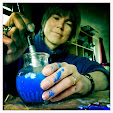It was lovely to lie on the dry ground and listen to the Bumble Bees humming between the Red Clover flowers. Because the meadow was so open I could get a great view of a male Skylark (below) which was displaying to a female on the ground. Normally derided as LBJ's, or Little Brown Jobs, I was close enough to see the bold patterning of his plumage.

In complete contrast to the Machair, the "in by" land around the farmhouse is allowed to grow up into an annual multistory grassland jungle. Plants layer one above another as they reach for the sky, fueled by a rich soil. Nettles, cow-parsley and hogweed jostle for space, and provide perfect cover for the shy Corncrake (below). These rare birds arrive from Africa in the Spring, and dive straight into the safety of the thick vegetation that has been grown for them. I sat for ages at the corner of the field, listening to a cacophony of rasping calls, as 7 male corncrakes each staked their claim to a patch of meadow. I often find that when I'm sitting still and drawing, wildlife eventually forgets I'm there. Eventually I was rewarded with a brief, tantalizing glimpse of this noisy bird.



No comments:
Post a Comment